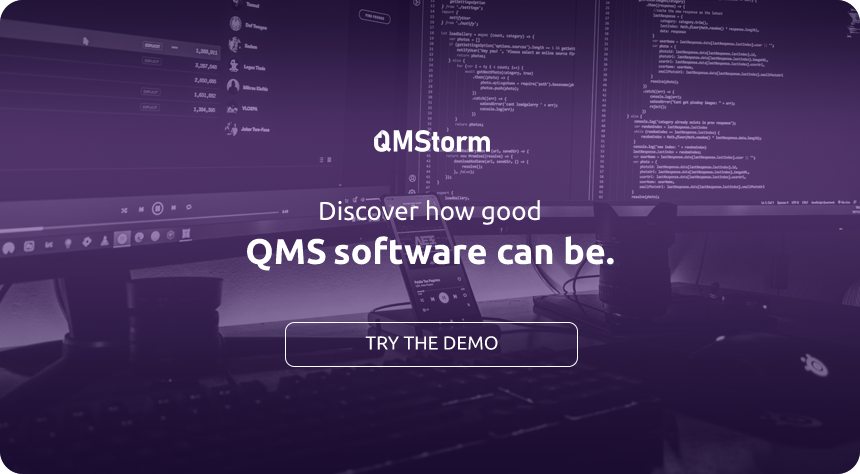There are many ways to manage quality. Just a few years ago, spreadsheets were mainly used for this purpose, and binders with the required documentation piled up in the archives. Today, this process can be greatly simplified and organized. The QMS application is a solution that supports effective quality management. Here’s what you need to know before purchasing QMS software.
Spis treści
QMS – what is it?
Quality Management System (QMS), i.e. the Quality Management System (QMS) is, to put it simply, a set of standards, procedures and processes that aim to ensure the best quality of products manufactured or services provided by the company. Going deeper, the QMS will be an ordered structure that includes documentation, rules, company policy, methods and techniques used, training and personnel management, various security standards, audits, risk management, or CAPA.
QMS supports the company’s internal standards and ISO standards (e.g. ISO 9001, ISO 17025) and good practices (e.g. Good Laboratory Practice, Good Distribution Practice, Good Manufacturing Practice). What’s more, it can often be integrated with management systems typical for specific industries, e.g. LIMS systems.
Quality management system – which will be the best?
Which quality management system to choose? This question should be considered in two categories – in terms of the system as a set of specific standards and methods and the system as a tool, i.e. an application, software or spreadsheet.
What are quality management systems?
Quality management systems can be classified as: in terms of norms and standards that we want or need to implement, but also in terms of method or goal orientation. We always choose a QMS that reflects the company’s policy and needs and leads to development.
In the case of standardized QMS, we are talking about, for example, ISO 9001, ISO 17025, ISO 14971. For some enterprises, the implementation of a specific ISO standard is a requirement, but there are also enterprises that, in order to increase quality and prestige, decide to adapt to given standards. A good example of this approach is the ISO 9001 standard.
Among the methods of quality management, we also distinguish systems such as:
- Total Quality Management – TQM, which emphasizes quality in every aspect of the functioning of enterprises and long-term development.
- Continuous Quality Improvement – CQI, which is focused on continuous quality improvement.
- Six Sigma, which focuses on achieving perfection in quality by defining, measuring, analyzing, improving and controlling.
QMS can also be divided into those oriented to:
- company performance
- functioning of the organization
- organizational culture
- customer.
Software for the Quality Management System.
Good QMS software is one that is tailored to the individual needs and requirements of the company, and also supports the selected quality management model. It can be said that it is tailored to the needs of a specific company. Therefore, we usually have two options to choose from – ordering a project and developing a program for our company, or purchasing a ready-made QMS application.
Our own program for the QMS seems to be the best solution, because by commissioning its implementation, we can freely design its functionality, as well as expand the application with new options over time. Of course, this is also the most expensive solution, because each program change or repair of possible failures is an additional cost. We must also be prepared that the development of such a program will require much more time than the implementation of a ready-made QMS application, because our own program will require many tests, in which the company’s employees will also have to be involved.
Ready-made software for the quality management system is a cheaper option and definitely faster to implement. In this case, the key is to choose the right system that will be flexible, thanks to which we will adapt its functionality to the needs of the QMS in our company. Many systems have dedicated modules for managing individual segments, i.e. documents, audits, training, CAPA, risk management, etc.
It is important in both cases to pay attention to the possibility of expanding the program and technical support after the completion of the implementation of the QMS system, as well as training of employees. When choosing a system, we also pay attention to its responsiveness, which will allow us to work on various devices (smartphone, tablet) and compatibility with various operating systems (Linux, Windows, macOS).
What are the benefits of implementing an IT system to QMS?
Regardless of whether we choose a ready-made QMS application or our own quality management program, we will receive a tool that will significantly speed up and facilitate work in our company. IT quality management systems allow you to organize and unify the entire structure
QMS, which consists of both documentation, processes, as well as all activities and relationships related to personnel or equipment.
Benefits of implementing IT quality management systems on the example of the QMStorm application:
- structured information, easily accessible in one place
- faster and more efficient flow of information
- monitoring and control of events, processes, personnel and access
- the ability to plan processes and tasks (e.g. audits, training)
- quick task assignment and progress tracking
- implementation of documents and activities supporting specific ISO standards
- faster and more efficient reporting
- flexible modules tailored to the needs of the company
- reporting of selected processes and information.





